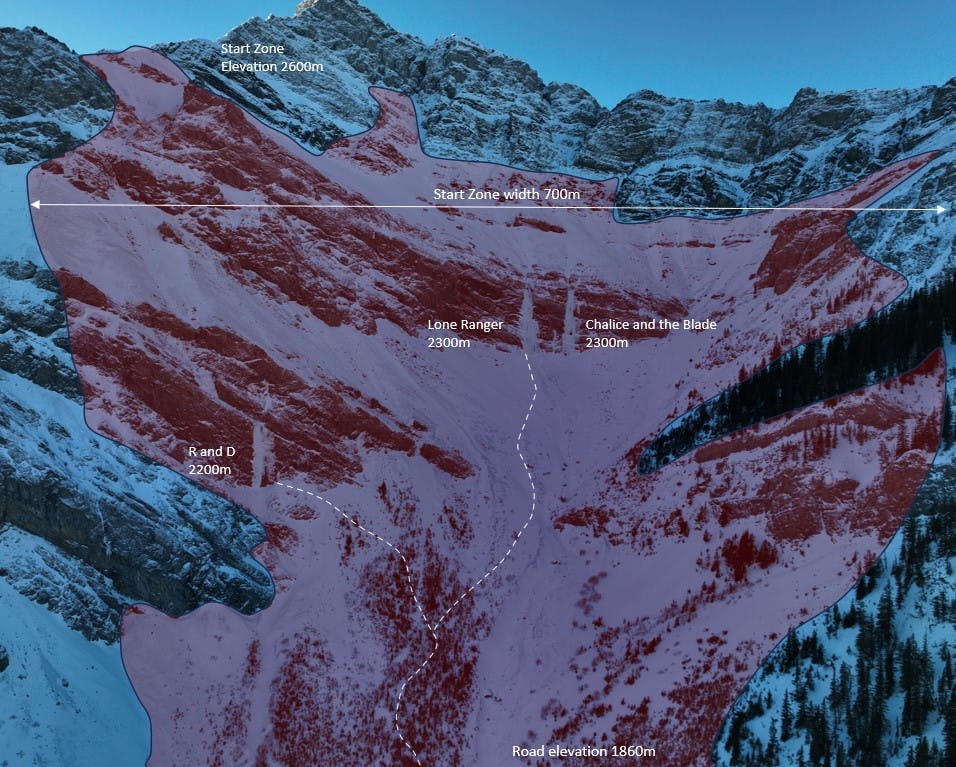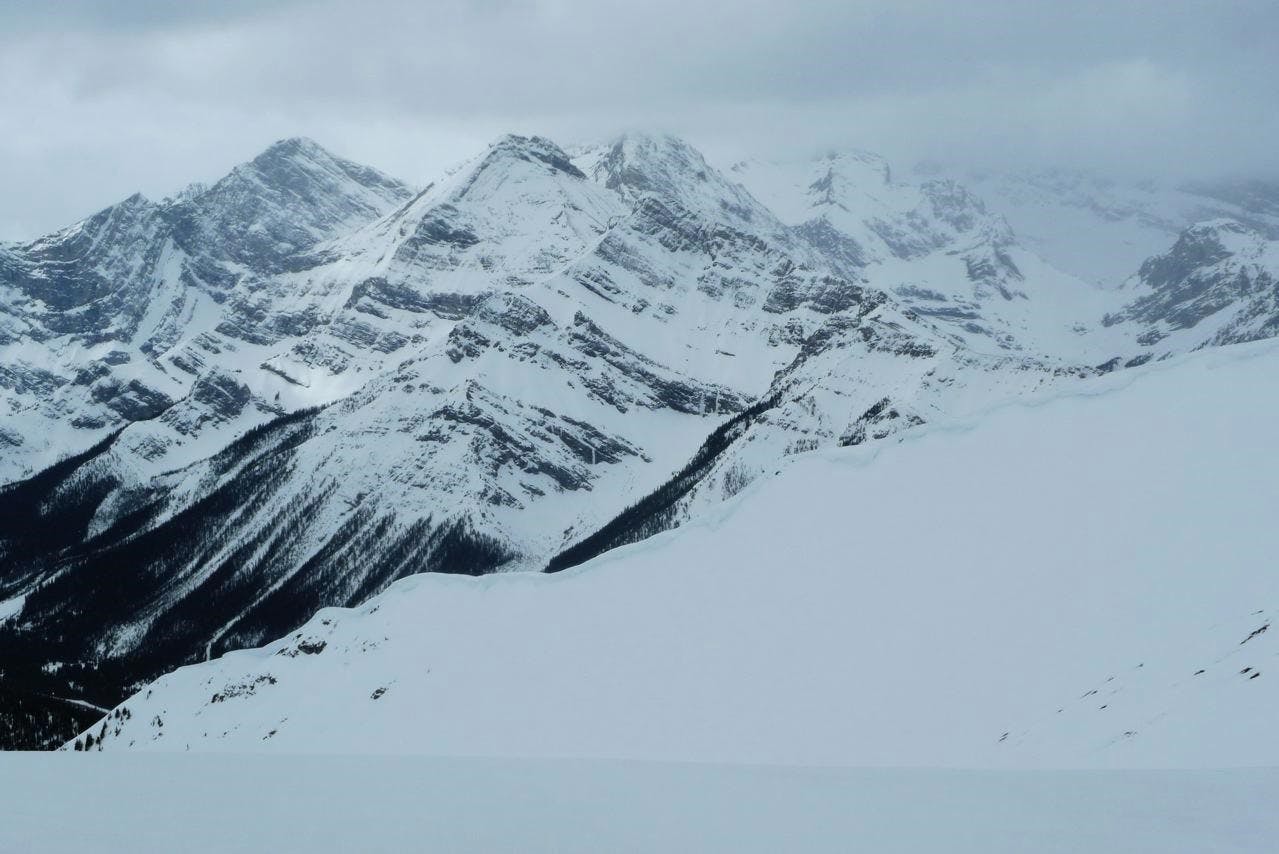
Photo: The Ranger Creek ice climbs, from left: R&D, Lone Ranger, and Chalice & the Blade. The image also shows the avalanche start zones above.
Ranger Creek is a popular venue for early season ice climbs. There are three main ice climbs here—R&D, Lone Ranger, and Chalice & the Blade—that are one to two pitches in length, as well as a few obscure, rarely forming mixed climbs. It is some of the first reliable ice to form in Kananaskis country and therefore becomes very popular and busy.
Located off the Spray Lakes trail, past Burstall Pass, the climbs involve about an hour approach and lie just above tree line. They all have serious avalanche terrain above and below the climbs. Climbers frequent these routes primarily between October and December, when the snowpack is minimal, however numerous incidents have still occurred during this time.
The survey was an attempt to consolidate the climbing community’s historical experiences with avalanche observations in the area. For the majority of the respondents, Ranger Creek is an early season objective. As a result, avalanche size and frequency has been summarized for October and November. Later in the winter, avalanches are likely more numerous and larger.
Climbs (rating)
- Lone Ranger: 3+, ATES 4 (Extreme)
- R & D: 5, ATES 3 (Complex)
- Chalice and the Blade/Spoon, ATES 4 (Extreme)

Popularity
- 54 people completed the survey
- 50% climbed 1–5 times
- 33% climbed 6–10 times
- 17% climbed over 10 times
Avalanche frequency
- 57% of respondents saw avalanche debris on approach
- 39% witnessed or experienced avalanches
Time of year and day
- 94% of respondents climbed in October and November (the avalanche observations are from this time)
- 73% made avalanche observations from 6 a.m. to 12 p.m.
Avalanche start zone
- 57% of respondents believe the avalanche started just above the climb
- 27% of respondents believe the avalanche started well above climb
- 7% of respondents believe the avalanche started below the climb
Runout debris
- 32% ran over the climb to base
- 32% ran 50–100 m past climb
- 28% ran over 100 metres past climb
- Debris has been seen as far as the choke point of the valley. Debris amounts and distance has indicated large (Size 3) avalanches.

Looking at the Ranger Creek climbs and the serious avalanche terrain above it.
Reported avalanches and incidents
- A party of two had just finished climbing the Lone Ranger and were starting their descent on foot from the base of the climb when they were struck from above by a size 2 wind slab avalanche. They were swept into a gully feature on the slope below. One member of the group was partly buried and able to dig themselves out. The other member was fully buried and did not survive. The wind slab avalanche had developed rapidly above a reactive crust that had formed on November 10, 2023. Other dry loose and wind slab avalanches were noted to have occurred in the area.
- Size 2 avalanche over R & D while climbing. Climber jumped off and dug themselves in behind the ice while belayer endured avalanche, but wasn’t swept or buried due to rope connecting them. Both impacted greatly and bruised from rocks and debris.
- Below Chalice & the Blade: hit from above and swept down the slope.
- Lone Ranger: one almost full burial and two partial burials
- Rescued people on route and responded to an avalanche involving six people
- Climber triggered avalanche on approach to R & D directly below climb. Lost gear and experienced minor injuries.
- While on Chalice: witnessed two Size 2 avalanches to our right.
- Smaller multiple avalanches around R & D
- Size 1 over R & D
- On approach: kicked off small, Size 0.5 slide
- Buried to knees at base of Lone Ranger
- Many sluffing and spin drift
- Witnessed Size 3 avalanche from the road.
Contributing factors
- Winds: gullies above climbs affected by lee deposits and high winds; makes walk-offs less desirable.
- New snow amounts: these are often greater than recorded at the nearby Mud Lake and Burstall Pass weather stations.
- Solar effect or warming: one person noted inversions for the area as something to be aware of.
Summary
- Can be a very busy area in early season, with people waiting in line for climbs and climbing at all hours of the day.
- Due to a lack of resources in early season, scarcity bias likely plays a role in climbers' decision making for this area.
- Most climbers are very aware of avalanche hazard and approach the area with caution and respect. They limit exposure once snow is at threshold for avalanches.
- Most climbers consider themselves to be very conservative in their approach to climbing in the area.
- With this said, many have also experienced or witnessed avalanches in the area.
- There is no cell coverage in Ranger Creek, so people should carry a satellite communication device.